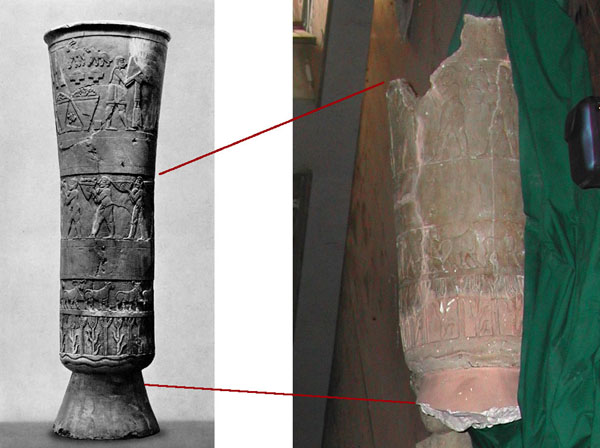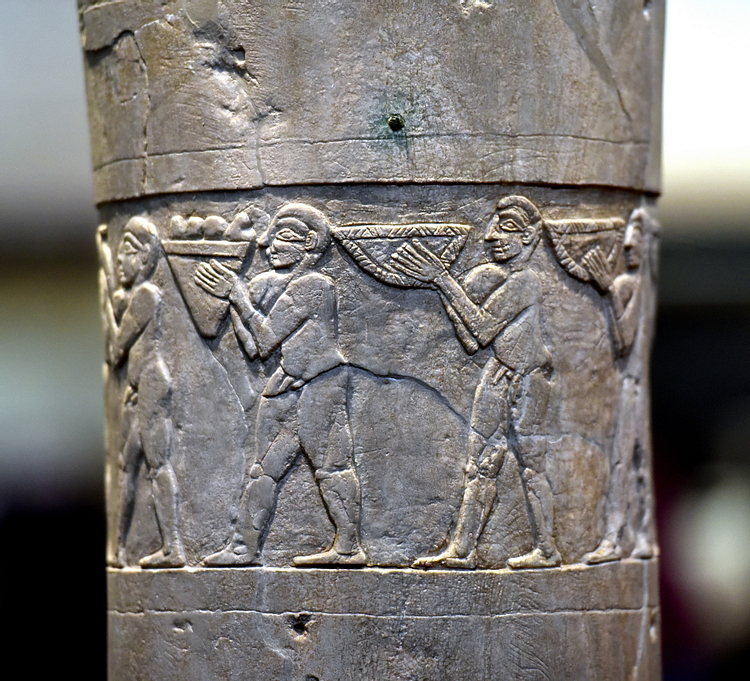The ancient world is filled with remarkable artistic achievements that continue to captivate and inspire us today. One such masterpiece is the Warka Vase, an exquisitely carved alabaster vessel that stands as a testament to the artistic prowess and cultural richness of the Sumerian civilization. This blog post will delve into the fascinating history, intricate details, and enduring significance of this iconic artifact.
The Discovery of the Warka Vase

The Warka Vase, also known as the Uruk Vase, was discovered in the early 20th century by German archaeologists excavating the ancient city of Uruk, located in modern-day southern Iraq. In 1933-1934, during the sixth excavation season at the site, the vase was found in fragments within the temple complex dedicated to the Sumerian goddess Inanna, one of the most important deities in the Mesopotamian pantheon.
The vase, which stood approximately 3 feet and 1/4 inch (1 meter) tall, was meticulously documented by the expedition team, who noted its impressive size and the presence of intricate flat-relief carvings adorning its surface. The find was recorded as “W14873” in the expedition’s field notes, with an entry dated January 2, 1934 describing the “large container of alabaster, circa 96 cm high with flat-reliefs.”
The Artistic Masterpiece
The Warka Vase is considered one of the earliest surviving works of narrative relief sculpture, showcasing the remarkable artistic skills of the Sumerian people. The vase is divided into three distinct registers, or tiers, each depicting a different aspect of Sumerian life and culture.
The bottom register of the vase portrays the natural environment of the Tigris and Euphrates river delta, with carefully rendered depictions of reeds and cultivated grains. This section serves as a visual representation of the rich agricultural landscape that sustained the Sumerian civilization.

The middle register features a procession of nude male figures carrying bowls and jars, presumably containing sacrificial offerings such as fruit and grain. This section provides a glimpse into the religious rituals and ceremonial practices of the Sumerian people.
The top register of the vase is the most visually striking, depicting a full scene rather than a continuous pattern. At the center stands the figure of the goddess Inanna, signified by the two bundles of reeds behind her. A figure in ceremonial clothing, likely a chieftain or priest, stands nearby, while the procession from the middle register approaches the temple area.
The intricate details and symbolic imagery of the Warka Vase offer a window into the complex religious, social, and cultural beliefs of the Sumerian people, making it a truly remarkable work of art.
The Tragic History and Restoration

The Warka Vase has endured a tumultuous history, including a period of loss and recovery that underscores the fragility of cultural heritage in times of conflict. During the 2003 Invasion of Iraq, the vase was one of the thousands of artifacts looted from the National Museum of Iraq. In April of that year, the vase was forcibly removed from its display case, snapping at the base and leaving the foot attached to the smashed case.
Fortunately, the vase was later returned to the Iraq Museum on June 12, 2003, by three unidentified young men. However, the vase had been broken into 14 pieces, and significant damage was observed at the top and bottom of the vessel. The restoration process began, with the goal of preserving this priceless cultural treasure.
The current condition of the Warka Vase is not publicly known, as the ongoing security challenges in Iraq have made it difficult to access and assess the status of the museum’s collections. The looting and damage to the vase serve as a sobering reminder of the fragility of our shared cultural heritage and the importance of protecting and preserving these irreplaceable artifacts.
The Enduring Significance of the Warka Vase

The Warka Vase stands as a testament to the artistic and cultural achievements of the Sumerian civilization, which flourished in Mesopotamia over 5,000 years ago. This remarkable artifact provides a glimpse into the religious beliefs, social structures, and artistic traditions of one of the earliest urban civilizations in human history.
The vase’s intricate carvings and symbolic imagery have captivated scholars and art enthusiasts alike, inspiring further research and study into the Sumerian world. The Warka Vase is not only a stunning work of art but also a valuable historical document that enhances our understanding of the ancient Near East and the foundations of human civilization.
Conclusion

The Warka Vase stands as a testament to the enduring power of art and culture to transcend the boundaries of time and space. This remarkable artifact, with its intricate carvings and rich symbolic meaning, continues to captivate and inspire us, reminding us of the profound artistic achievements of the Sumerian people and the importance of preserving our shared cultural heritage. As we reflect on the Warka Vase, we are reminded of the timeless beauty and significance of the ancient world, and the ongoing need to protect and safeguard these irreplaceable treasures for future generations.
